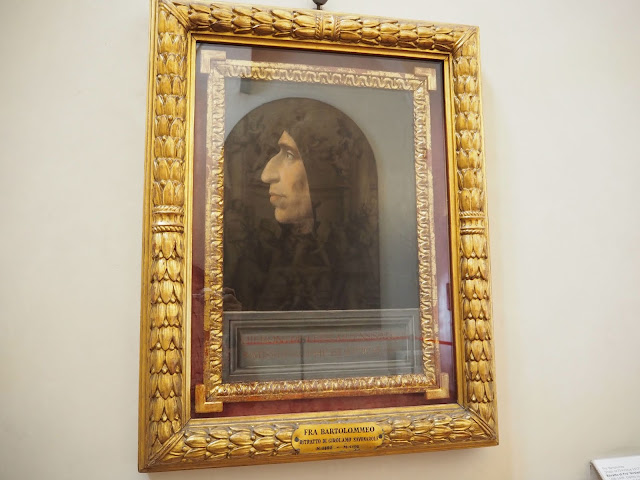【フィレンツェ】サン・マルコ美術館とサヴォナローラ Firenze - Museo di San Mrco & Girolamo Savonarola
サン・マルコ美術館には、サヴォナローラに関する展示品もある。
フラ・バルトロメオが描いた有名なサヴォナローラの肖像画も展示されていた。
サヴォナローラは、1452年にフェラーラで生まれ、ボローニャでドミニコ会の修道士になり、1482年になってこのサン・マルコ修道院に転院してきた。
The San Marco Museum also has exhibits related to Savonarola.
A portrait of the famous Savonarola by Fra Bartolomeo was also on display.
Savonarola was born in Ferrara in 1452, became a Dominican monk in Bologna, and was transferred to the San Marco monastery in 1482.
サヴォナローラを称える巨大な大理石のプレートも置かれている。
サヴォナローラがフィレンツェにやってきた時は、ロレンツォ・デ・メディチがフィレンツェを支配しており、その繁栄の頂点にあった。
サヴォナローラは、繁栄の中で享楽的な生活を送っていたフィレンツェの人々を強烈に批判して、清貧に生きるように訴えた。
サヴォナローラの説教は、次第にフィレンツェの人々の心を捉えていった。その演説力は抜群だったようで、説教を聴きながら感激のあまり泣き出してしまう人も数多くいたらしい。
There is also a huge marble plate in honor of Savonarola.
When Savonarola arrived in Florence, Lorenzo de'Medici ruled Florence and was at the height of its prosperity.
Savonarola strongly criticized the Florentine people, who lived a prosperous and enjoyable life, and urged them to live in poverty.
Savonarola's sermon gradually captured the hearts of the Florentine people. His speech ability seemed to be outstanding, and it seems that there were many people who were so moved that they started crying while listening to his sermon.
サン・マルコ美術館の2階の奥まった部屋は、サヴォナローラの僧坊と名つけられていて、サヴォナローラの遺品などが展示されている。
この部屋にあったサヴォナローラの肖像画は、フラ・バルトロメオの描いた肖像画とは少し異なった表情だ。
フラ・バルトロメオは、フィレンツェに生まれて画家として活躍していたがサヴォナローラの演説に影響を受けて、その後、サヴォナローラが亡くなった後だったが、この修道院で修道士となった。
The recessed room on the second floor of the San Marco Museum is named Savonarola's monk, and exhibits Savonarola's relics.
The portrait of Savonarola in this room looks a little different from the portrait of Fra Bartolomeo.
Fra Bartolomeo was born in Florence and was a painter, but was influenced by Savonarola's speech and later became a monk at the monastery after Savonarola's death.
サヴォナローラはとりわけ、ロレンツォ・デ・メディチを批判した。
この修道院は、コジモ・デ・メディチが自らの資金で建設した修道院だった。そこからメディチ家を批判する修道士が出るとは、コジモは思いもよらなかったろう。
ロレンツォは、1492年4月8日に病のために亡くなってしまう。死の前に、サヴォナローラを自邸に招いて自らの罪を懺悔したという。
当時、フィレンツェにはフランスのシャルル8世の軍隊が迫っていた。サヴォナローラはフィレンツェの代表として交渉して和議を勝ち取った。フィレンツェ市民のサヴォナローラへの信頼はさらに高まった。
その後、サヴォナローラは6年間にわたりフィレンツェを実質的に支配した。
Savonarola, among other things, criticized Lorenzo de'Medici.
The monastery was built by Cosimo de'Medici with its own funds. Cosimo wouldn't have expected that there would be a monk who criticized the Medici family.
Lorenzo died of illness in 1492. Prior to his death, he invited Savonarola to his home and repented of his sins.
At that time, the army of Charles VIII of France was approaching Florence. Savonarola negotiated on behalf of Florence and won the consensus. The confidence of Florentine citizens in Savonarola has further increased.
Savonarola then virtually dominated Florence for six years.
サヴォナローラは、美術品や装飾品を集めてシニョーリア広場で焼却するなどの過激な施策を行い、ボッティチェッリやフラ・バルトロメオなども自らの作品を進んで差し出した。
しかし、ローマ教皇アレクサンドル6世を批判したことで逆に破門を宣告され、フランシスコ会の修道院から”火の裁判”を要求されたが躊躇したことなどから、次第にフィレンツェ市民の信頼を失っていった。
そして遂に、サン・マルコ修道院に詰めかけた群衆によって拘束されて、裁判で死刑を宣告されてしまう。
最後は、自らが美術品などを焼却した同じシニョーリア広場で、絞首刑の後でさらに火破りの刑に合うという悲劇的な死を迎えた。1498年5月23日のことだった。
サヴォナローラの僧坊の壁には、その処刑の直後に描かれたという有名な絵が展示されている。
奇妙なことに、広場に描かれている人たちは、処刑のことなど気にせずに、立ち話をしたり遊んだりしている。
フィレンツェの人たちにとっては、サヴォナローラの神権政治もまた、壮大な見せ物のひとつだった、ということかもしれない。
Savonarola took radical measures such as collecting works of art and ornaments and incinerating them in Piazza della Signoria, and Botticelli and Fra Bartolomeo were also willing to present their works.
However, he was sentenced to excommunication for criticizing Pope Alexander VI, and hesitated to request a "fire trial" from a Franciscan monastery, but he gradually lost the trust of the Florentine citizens.
Finally, he was detained by a crowd of people in the San Marco monastery and sentenced to death in court.
At the end, he died tragically at the same Piazza della Signoria, where he incinerated the works of art, after being hanged and then sentenced to more fire.
On the wall of Savonarola's monk is a famous painting that was painted shortly after his execution.
Oddly enough, the people depicted in the square are talking and playing without worrying about the execution.
For the Florentine people, Savonarola's theocracy may also have been one of the grand spectacles.
(Translated by Google Translate)







コメント
コメントを投稿